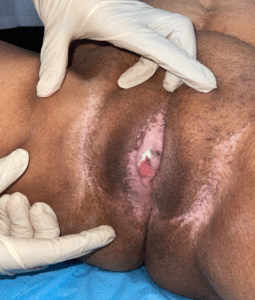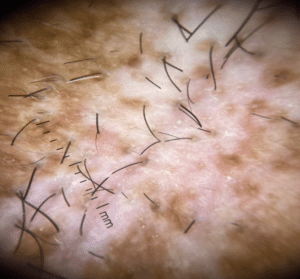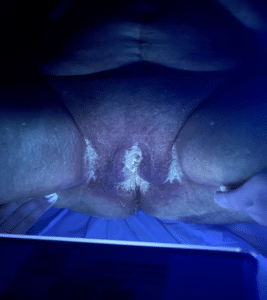Imane Kacimi Alaoui1*, Zakia Douhi1, Siham Boularbah1, Meryem Soughi1, Sara Elloudi1, Hanane Baybay1, Fatima-Zahra Mernissi1
1Department of Dermatology, University Hospital Hassan II, Fes, Morocco
*Correspondence author: Imane Kacimi Alaoui, Department of Dermatology, University Hospital Hassan II, Fes, Morocco; Email: [email protected]
Published Date: 29-04-2023
Copyright© 2023 by Alaoui IK, et al. All rights reserved. This is an open access article distributed under the terms of the Creative Commons Attribution License, which permits unrestricted use, distribution, and reproduction in any medium, provided the original author and source are credited.
Letter To Editor
Melanocytes respond to trauma or cutaneous inflammation by producing varying amounts of melanin, which manifests as either hyperpigmentation or hypopigmentation. Post inflammatory Hypopigmentation (PIH) is an acquired partial or total loss of skin pigmentation that occurs after cutaneous inflammation or injury [1]. Mechanisms and pathogenesis of PIH remain unclear. It is difficult to understand how individuals respond to inflammation differently. Skin discoloration is the primary clinical indication of pigment incontinence [2]. Vitiligo, another disease that presents similarly, is often confused with PIH. Significant contrast in wood light and dermoscopy can lead to a positive diagnosis of vitiligo.
The most common malignant neoplasm affecting the vulva is Vulvar Squamous Cell Carcinoma (VSCC). It accounts for approximately 90% of all cases of vulvar cancer. The majority of female vulvar squamous cell cancer cases occur after menopause [3]. The causes of VSCC are multifactorial, with a number of risk factors identified, including infection with Human Papillomavirus (HPV), chronic inflammation, and immunodeficiency [4].
A 56-year-old woman presented with a very pruritic erosive genital dyschromia evolving for 2 years, motivating her consultation in gynecology where a biopsy was performed showing a vulvar epidermoid carcinoma. The patient was referred to our training for suspicion of an associated vitiligo. Examination of the genital region revealed a well-limited hyopigmentation of regular contours involving the vulva and the inguinal folds bilaterally, with an erosive leukoplakic plaque affecting the small lip (Fig. 1). Dermoscopy showed a hypopigmentation pattern with perifollicular pigmentation and telangiectasias (Fig. 2). In front of the suspicion of a vitiligo, the wood’s light did not mark a contrast (Fig. 3) and the diagnosis was in favor of a post-inflammatory hypopigmentation. The patient was readdressed in gynecology for further management.
Hypopigmentation can be caused by chronic inflammatory conditions that increase the risk of VSCC [2]. Therefore, it is crucial to closely monitor and manage any chronic vulvar inflammation to reduce the risk of VSCC and associated skin changes [3].

Figure 1: Well-limited hypopigmented placard involving the genitalia and inguinal folds.

Figure 2: Dermoscopy showed hypopigmentation pattern with perifollicular pigmentation and telangiectasias.

Figure 3: The wood’s light marks a light contrast.
Keywords: Vulvar Squamous Cell Carcinoma; Pigmentation; Dermoscopy; Leukoplakic Plaque
Conflict of Interest
The authors have no conflict of interest to declare.
References
- Gutierrez P, Gandhi K, Amakiri N, Garza J, Ventolini G. Vulvar lesion mimicking vitiligo: A case report. Case Rep Womens Health. 2020;27:e00234.
- Vachiramon V, Thadanipon K. Postinflammatory hypopigmentation. Clin Exp Dermatol. 2011;36 (7):708-14.
- Muigai J, Jacob L, Dinas K, Kostev K, Kalder M. Potential delay in the diagnosis of vulvar cancer and associated risk factors in women treated in German gynecological practices. Oncotarget. 2018;9:8725-30.
- Olawaiye AB, Cuello MA, Rogers LJ. Cancer of the vulva: 2021 update. Int J Gynaecol Obstet. 2021;155(1):7-18.
Article Type
Review Article
Publication History
Received Date: 06-04-2023
Accepted Date: 23-04-2023
Published Date: 29-04-2023
Copyright© 2023 by Alaoui IK, et al. All rights reserved. This is an open access article distributed under the terms of the Creative Commons Attribution License, which permits unrestricted use, distribution, and reproduction in any medium, provided the original author and source are credited.
Citation: Alaoui IK, et al. Vulvar Lesion Mimicking Vitiligo Revealing a Squamous Cell Carcinoma. J Dermatol Res. 2023;4(1):1-3.

Figure 1: Well-limited hypopigmented placard involving the genitalia and inguinal folds.

Figure 2: Dermoscopy showed hypopigmentation pattern with perifollicular pigmentation and telangiectasias.

Figure 3: The wood’s light marks a light contrast.


